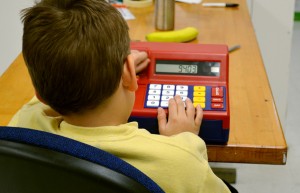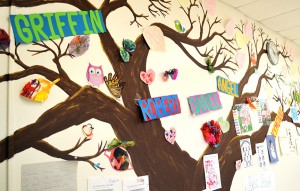
On the wall of a very special classroom hangs a piece of red construction paper embossed with the words, “Each of us is a flower growing in life’s garden.”
Surrounding the message are the photos children with autism who attend one of Tucson’s special needs schools.
Autism spectrum disorder now affects 1 in 68 children in the United States, according to an estimate released by the Centers for Disease Control in late March.
The autism program at Intermountain Centers for Human Development, which began taking shaped at the beginning of the 2013 school year, has garnered the attention of many parents within the special needs community.
“This is an opportunity for Robert to grow through adolescence without being teased and taunted like he would be in a regular school,” said Karen Barela, grandmother of Robert Barela, an 11-year-old with a dual diagnosis of autism and seizure disorder.
Originally located in South Tucson, the school had an enrollment of only 12 students, none of whom had autism.
Since moving to its new location just south of Broadway Boulevard this school year, the number of students with autism enrolled at the school has increased from 4 to 23, which makes up 50 percent of the school’s total enrollment of 46 students, Education Director Tyson Gillespie said.
[box]
About Intermountain
Originally founded in Tucson in 1973, under the name of the Southwest Indian Youth Center, Intermountain Centers for Human Development has since expanded its services to include:
- Group homes
- Foster care
- Day programs
- Schools for special needs children
The goal of the organization is “to assist each child, adult and family individually, in identifying and achieving their personal goals through the least restrictive and most positive means.”
For information visit their website or call (520) 721-1887 [/box]
The school serves children from across Pima County.
Out of all the parents who seek Intermountain for services, parents of children with autism are doing so at the fastest rate, Gillespie said. He thinks that one of the reasons for this influx is the work of the school’s lead autism teacher Cyndee Wing, who is also works as a behavioral health analyst.
At the foundation of Wing’s autism curriculum is an emphasis on “functional skills,” which means not only teaching the students academics but life skills as well.
One way Wing manifests this ideology is by encouraging her students to help tend to a small garden just outside the classroom.
The elevated rectangular box is blanketed with mahogany-colored soil. The leaves of a basil plant cascade over an a menagerie small sprouts just beginning to peek out from the soil.
Inside the classroom, there is a full-size kitchen where students learn to cook their own meals. For student birthdays, the class bakes a cake together.
Down the hall, which encompasses the school in a circular fashion, is an indoor pool. This amenity is especially useful for children with autism because it is a way for them to exercise with positive sensory input, Wing said.
Although the students do not get to swim everyday, they do get participate daily in a specially designed physical education class which takes place in a large multi-purpose room located in the center of the school.
The class begins as the children form a circle to stretch. Some look competitively at their neighbors and dive toward their own toes, while other wonder off away from the group.

“There’s a little bit of chaos sometimes,” Wing said. “But that’s what life is like.”
This “chaos” is why children with autism often get left out of group activities at pubic schools, Wing said.
“People come here because they are looking for a solution for kids who were on the sidelines at their old schools,” Wing said. “There are other options in Tucson but none to this scale.”
However, this kind of special instruction comes at a price. Tuition for a child with autism ranges from $26,000 to $30,000 for one school year, while rates for children without autism which range from $15,000 to $20,000, Gillespie said.
Tuition is more expensive for students with autism because they often require more individualized attention, like the assistance of a personal aide who works with the child in addition to his or her regular teacher.
Gillespie said that low-income families should not be discouraged from applying because there are scholarships available. About 90 to 95 percent of the school’s current students come from low-income families, he said.
The tuition money not only helps pay the salaries of the school’s staff members, but also allows the students to go on field trips throughout the year.
[box]
How to apply
Typically, the public school that the student currently attends must make a referral in order for the student to transfer to Intermountain. When that happens, the public school is responsible for paying part of the student’s tuition if the family cannot afford it.
If student’s public school refuses to make a referral and the parents still want their child to attend Intermountain, they can request a private enrollment.
The following scholarships are available:
Institute for Better Education Corporate Scholarship
Arizona Leadership Foundation Corporate Scholarship
Disabled/Displaced Student Scholarship [/box]
A collection of paper cacti peppered with hand-drawn spines, created after an adventure to Sabino Canyon, decorates the wall that leads to Wing’s classroom.
Like most of the group activities the class does together, trips like this do not come without hiccups. Extra sets of hands are often required, Wing said.
“These kids are able to do things they wouldn’t be able to do at other schools because of safety concerns,” Gillespie said. “However, since we have a support staff in place they are able to do some really great hands-on learning.”
Even at the end of harder days, Wing said that the reward of enriching her students’ lives is worth the bumps and bruises she has encountered along the way.
The message on the red construction paper hanging in her classroom offers the following reminder: “Each of us is a flower. We need the sun and the rain.”

